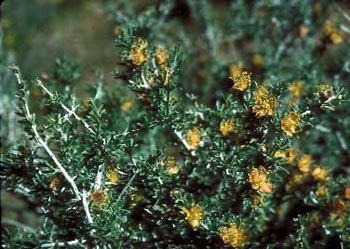Blackbrush

Common Name(s):
Blackbrush
Scientific Name:
Coleogyne ramosissima Torr.
Scientific Name Synonyms:
None known
Symbol:
CORA
Description:
Life Span: Perennial
Origin: Native
Season: Evergreen
Growth Characteristics: An aromatic shrub, with opposite branches that are short and rigid, becoming spinescent with age. It forms nearly pure stands on large areas. Blackbrush flowers March to May and reproduces from seeds. Fruit and seed formation occur only in years of good to abundant precipitation.
Flowers/Inflorescence: Blackbrush flowers are solitary and found on the ends of young branchlets. The flowers are greenish-yellow to purple, and lacking petals. The color is due to the sepals.
Fruits/Seeds: Fruits are dry, smooth achenes, somewhat flat, with a long, bent and twisted, thread-like stalk on one end. Long, dense hairs.
Leaves: Opposite, in crowded fascicles. Blades linear, margins entire, and rolled under. Surface is hairy with pick-shaped hairs.
Stems: Twigs opposite and widely divergent. They are often spine-like at the tip. The bark is gray to ashy, becoming black with age or when wet. The wood is soft and deeply furrowed.
Ecological Adaptions:
Blackbrush occurs primarily in the transition zone between the Mojave and Great Basin deserts, and on the western border of the Sonoran desert, on mesas, open plains, and foothills. It is found at elevations from 2,500 to 7,000 feet in areas where the annual temperature fluctuation can range from -11 degrees to 116 degrees Fahrenheit. It is drought-deciduous, meaning that it avoids water stress by becoming temporarily dormant and then shedding its older leaves as stress intensifies during the dry season. Spiny stems, coupled with chemical compounds in current years growth, protect blackbrush from heavy browsing. Establishment from seed by this species is rare, requiring two good moisture years in succession in order to reproduce.
Soils: Dry and well-drained soils. Blackbrush is most abundant in sandy, gravelly, and rocky soils, often over an indurated hardpan or bedrock.
Associated Species: Blue grama, Utah juniper, bottlebrush squirreltail, ephedra, and cactus.
Uses and Management:
Blackbrush is not preferred as forage by domestic livestock, deer, or pronghorn, but is does provide poor forage during the spring, summer, and fall for domestic cattle, horses, and sheep. Mule deer and bighorn sheep generally use the blackbrush vegetation type in winter. Small mammals and birds consume blackbrush seeds.

